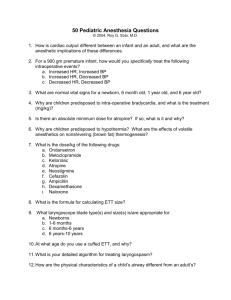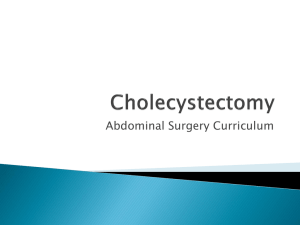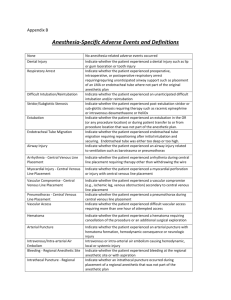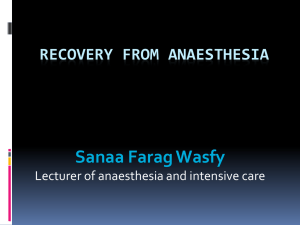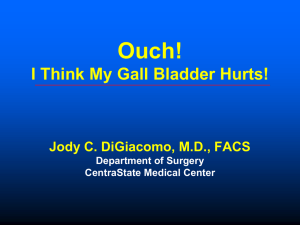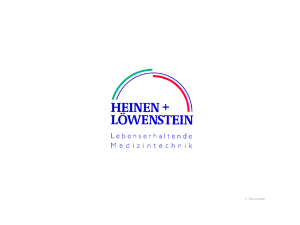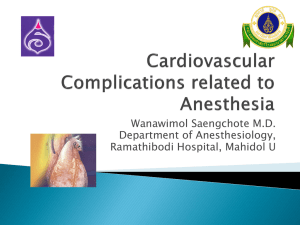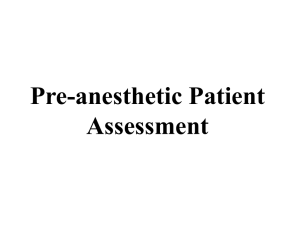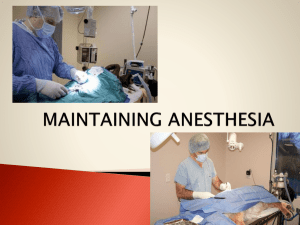Care Plans - School of Nurse Anesthesia
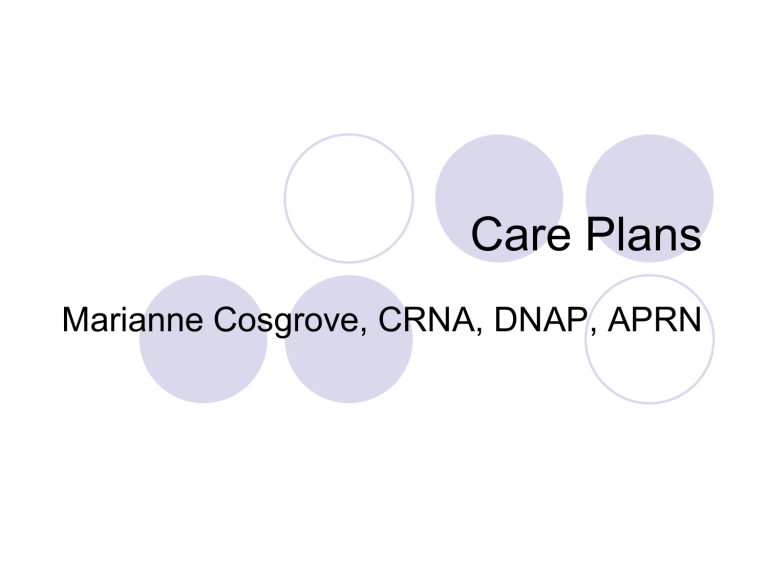
Care Plans
Marianne Cosgrove, CRNA, DNAP, APRN
Care Plans
Why?
To prepare for the case
Delineates procedure
• How it is performed
• Pt position
• Anesthetic considerations and plan for that specific type of surgery
• Anesthetic considerations for pt co-morbidities, meds
To prepare for testing/boards!
The initial portion of the care plan is done when you get your assignment → before the procedure
Pre-surgical Care Plan
Assignment:
J. Doe, male, age 49
Laparoscopic cholecystectomy
General anesthetic
Now what?
Presurgical Care Plan, cont’d
To be prepared for the AM of surgery:
Planned procedure:
In a synopsized form, explain the procedure to be done.
Add details only if it directly impacts your anesthetic plan of care.
If you are doing multiples of the same case, one cover sheet is acceptable for all cases scheduled; write the actual number of cases done that day on the cover sheet and attach each pt done to the procedure sheet before handing in
Presurgical Care Plan, cont’d
Research the planned procedure
Synopsize lap chole:
i.e. Laparoscopic approaches are applied to an increasing number of procedures, including cholecystectomy, the surgical excision of the gallbladder. Surgery is performed for acute/chronic cholecystitis and/or cholelithiasis. Benefits of the laparoscopic approach to cholecystectomy include:
• smaller incision(s)
• reduced post-operative pain
• reduced incidence of ileus
• early ambulation
• shortened hospital stay
• earlier return to work and ADLs
Laparoscopic Cholecystectomy, cont’d
Synopsis cont’d
Operative technique involves the intraperitoneal insufflation of CO
2 through a needle inserted through a small infraumbilical incision. Patient positioning in steep
Reverse Trendelenberg with a left side-tilt facilitates operative exposure of the gallbladder.
Pictures are OK but not necessary!! Check out Google
TM images
Presurgical Care Plan, cont’d
Anesthetic considerations for the procedure:
The most important part of your preparation for the case
“bullet” list format vs. paragraph may be easier to follow
“chunking” of information allows the adult learner to retain information better
Anesthetic implications for laparoscopic cholecystectomy
Hemodynamic changes associated with insufflation:
increase in MAP and SVR with no effect on CO in healthy patients
a decrease in CO and hypotension in hypovolemic pts or those with pre-existing cardiac disease
absorption of CO
2 across the peritoneum may result in hypercarbia with SNS stimulation, increased BP, CO, HR, and arrythmias
controlled ventilation with cuffed ETT
may note bradycardia due to vagal stimulation from peritoneal stretching during initial insufflation
pretreat with anticholinergic
periods of hypotension may occur with the pt in steep
Reverse Trendelenburg, especially if hypovolemic, betablocked, pre-existing cardiac dz, etc
Anesthetic implications for laparoscopic cholecystectomy
Respiratory changes:
reduction in FRC from cephalad movement of diaphragm, especially in Trendelenburg
atelectasis leading to hypoxia
need for PEEP if tolerated
decrease in abdominal and chest wall compliance due to presence of pneumoperitoneum
increases in peak airway pressures
necessity for increased minute ventilation to offset hypercarbia from insufflation with CO
2
May want to avoid N
2
O; may insufflate bowels making surgical exposure difficult; may add to hypoxia, may cause PONV
Anesthetic implications for laparoscopic cholecystectomy
Complications:
vascular injury/hemorrhage from large vessel or organ penetration with the Veres needle, trocars, or instruments
larger bore IV (at least #18g), T&S
hypothermia from insufflation with cold gas
actively warm pt
—fluid warmers, Upper body Bair
brachial plexus injury from supine/Trendelenburg position
secure arms
increased incidence of emesis, PONV
rapid sequence induction/intubation, antiemetics
pneumomediastinum, pneumopericardium, or pneumothorax and subcutaneous emphysema of the face and neck
venous gas (CO
2
s/s
) embolism
Treatment:
• increased ETCO
2
• hypoxia/decreased SaO
2
• hypotension (may be severe)
• “mill-wheel” murmur
-stop insufflation
-head down, L lateral decubitus position
-FiO
2
1.0
-support with pressors
Your generalized plan of care for the patient:
GETA vs. general LMA, vs. regional vs. TIVA, etc.
No need to delineate each step used to perform the type of anesthetic chosen; more important to know why the specific type of anesthesia was chosen for that case
Could this be alternatively performed with regional or
MAC/TIVA?
List drugs that you plan to use; be prepared re: dosage ranges for the agents that you have chosen.
Preliminary plan of anesthetic care
What is your proposed plan?
Rapid sequence induction (RSI) with GETA
Rapid sequence induction
• Know the rationale/steps —add to plan of care if applicable i.e.
• preoxygenate
•
HOB
↑ 30°
• working suction at HOB
• stylet in ETT
• induction med followed by rapid-acting NMB without testing airway
• cricoid pressure until intubation verified via ETCO
2
/auscultation
Choose medications, why you want to use them, and KNOW YOUR
DOSAGES!
Always have a contingency plan!!!
Preliminary plan of anesthetic care, cont’d
Plan: GETA with a rapid-sequence induction
Midazolam 1-2 mg IV for sedation
Fentanyl 50-100 mcg IV pre-induction
Glycopyrrolate 0.2 mg IV pre-induction
Propofol 2 mg/kg IV for induction
Succinylcholine 1 mg/kg for laryngoscopy/intubation
Sevoflurane/O
2
/air for maintenance
Rocuronium for ongoing relaxation
Ondansetron 4 mg for PONV prophylaxis
Neostigmine 0.04 mg/kg matched 1:1 with glycopyrrolate for reversal
References
Must have at least two references
1 web reference is acceptable
Hurford, W.E. Clinical Anesthesia Procedures of the
Massachusetts General Hospital. Philadelphia,
Lippincott, Williams & Wilkins, 2002. pp 318-320
Roizen MF, Fleisher, LA. The Essence of
Anesthesia Practice. Philadelphia: W.B. Saunders
Company, 2002. pg 384
Day of surgery
Now what?
Patient contact is made, chart review is done
Wt 198# / 90 kg Ht 6’0”
Pt history remarkable for smoking, major depression,
OSA
Medications: Prozac, loratidine and percocet PRN, nicotine patch
Labs all WNL
• transcribe all pertinent history onto care plan
During the case:
note anesthetic technique used
note medications/dosages used
at the end of the care plan, you will list these meds as
“actual”; note if there is a deviation from your original plan
jot down any interesting, unexpected, untoward events (including mishaps!)
anecdotal information will be added to finalize the CP before handing in —makes it more personalized and meaningful
will end up with a “journal” of anesthetic experiences
After the case is finished:
Revisit the care plan to review and add anesthetic implications for patient co-morbidities and meds, i.e.
OSA-obstructive sleep apneaa disorder in which excessive soft tissue in the upper airway intermittently obstructs the airway during sleep. Prevalence is more common in obese pts. Pts report snoring, daytime somnolence, intellectual impairment, repeated AM headaches. More serious cases may lead to RVH from increases in pulmonary vascular resistance during apneic/hypoxic periods.
May lead to cor pulmonale and eventual L-sided heart failure. Other resultant co-morbidities may include HTN, cardiac arrythmias, polycythemia, and vascular disease.
may be a difficult airway
—both bag/mask ventilation, laryngoscopy/intubation, and after extubation
• have a variety of airway implements on hand
• may use a nasal airway before extubation
may be sensitive to the respiratory depressant effects of opioids
• use opioids/sedatives with caution
After the case is finished, cont’d:
Smoking
Cigarette smoke contains > 3000 identifiable constituents, many of which are toxic (most notable are nicotine, CO, and cyanide). Smokers have:
increased airway irritability and secretions, decreased ciliary activity; potential for post-op pulmonary complications
• humidify gases
• lidocaine pre-intubation and extubation
• hydration
•
? use of anticholinergics
• ET suction before extubation
• ? deep extubation
COPD
• I:E ratio which allows for longer expiratory phase
• watch PIP
carboxyhemoglobinemia (COHb)
• Monitor SaO
2
↑ incidence of HTN, CAD, PVD, from SNS stimulation from nicotine
• ? use of β-blockers
Medications
Fluoxetine (Prozac)
A selective inhibitor of serotonin reuptake used to treat major depression, OCD, bulemia
anesthetic considerations:
pt may be ↑anxious
• use of benzodiazepenes
pt may have extrapyramidal reactions
• avoid dopaminergic blockers (droperidol, metoclopramide)
• serotonin syndrome with concomitant use of MAOIs, tricyclics, meperidine
monitor temperature
avoid use of meperidine
SIADH
• watch U/O if applicable
may inhibit cytochrome P-450 and potentiate the effects of phenytoin, benzos, beta-blockers due to increased plasma levels of these drugs
Finally…
Please complete these sections before re-submitting to your preceptor for signature
Post-op visit *If the pt is in STS, make an attempt to re-connect before their discharge to home; assess for pain,
PONV, untoward reaction to anesthesia, etc.
extremely important
Use the bottom of the preanesthesia assessment sheet to note the post-op visit
Hints for success
Save all of your co-morbidities and medications in a file folder on your computer
may re-submit on future care plans —work will already be done!
do not “trade” with peers
want to build your own library
Ultimate goal —to formulate a plan of care off of the top of your head
Care Plan CHECKLIST
Keeps track of cases
Based on the CCNAs outline for boards
All case types not mandatory but will give you an idea as to what needs to be focused on for studying later
Mandatory to have 3 OB rotation (1 C/S, 1 co-morbidity, 1 laboring epidural/vaginal delivery and 1 care plan/WEEK from rotation sites
Care Plan CHECKLIST
Before graduation, you must have at least one CP completed for each of the categories listed
Will upload/submit to the school as an electronic file, either separately or as a component of your e-portfolio

